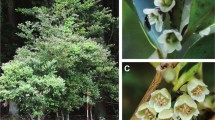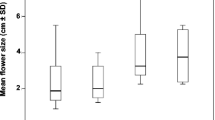Summary
ESS floral lifetimes satisfy the product theorem from sex allocation theory. The dimensionless time investment per flower is a symmetric function of two dimensionless gain : cost ratios, one for each gender function.
Similar content being viewed by others
References
Ashman, T.-L. and Schoen, D.J. (1994) How long should flowers live?Nature 371, 788–90.
Charnov, E.L. (1979) Simultaneous hermaphroditism and sexual selection.Proc. Natl Acad. Sci. USA 76, 2480–4.
Charnov, E.L. (1982)The Theory of Sex Allocation. Princeton University Press.
Charnov, E.L. (1993)Life History Invariants. Oxford University Press.
Charnov, E.L. and Parker, G.A. (1995) Dimensionless invariants from foraging theory's marginal value theorem.Proc. Natl Acad. Sci. USA 92, 1446–50.
Schoen, D.J. and Ashman, T.-L. (1995) The evolution of floral longevity: resource allocation to maintenance versus construction of repeated structures in modular organisms.Evolution, in press.
Stephens, D.W. and Dunbar, S.R. (1993) Dimensional analysis in behavioral ecology.Behav. Ecol. 4, 172–83.
Author information
Authors and Affiliations
Rights and permissions
About this article
Cite this article
Charnov, E.L. Optimal flower lifetimes. Evol Ecol 10, 245–248 (1996). https://doi.org/10.1007/BF01237682
Issue Date:
DOI: https://doi.org/10.1007/BF01237682




